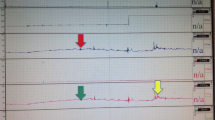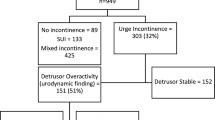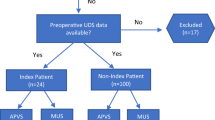Abstract
Introduction and hypothesis
We hypothesized that urinary symptoms in elderly females correlate poorly with urodynamic diagnosis, which would impact on management.
Methods
Charts of 53 consecutive females over age 80 undergoing multichannel urodynamics according to the International Continence Society standards were retrospectively analyzed.
Results
Median age was 83 years. Urodynamic stress incontinence was the most common diagnosis, in 26/53 (49%). Detrusor overactivity was found in only 12 (29%) of 42 females presenting with pure storage symptoms, and reduced compliance was seen in eight (19%). Urodynamics resulted in complete change in patient management in 43% of cases and helped 52% of referring physicians in confirming provisional diagnosis prior to drug or surgical treatment.
Conclusions
In octogenarian females, there is poor correlation between storage symptoms and urodynamic diagnosis. Thus, urodynamics guides patient management and may avoid empirical prescribing associated with adverse effects in this clinically vulnerable population.


Similar content being viewed by others
References
Elbadawi A, Hailemariam S, Yalla SV, Resnick NM (1997) Structural basis of geriatric voiding dysfunction VII. Prospective ultrastructural/urodynamic evaluation of its natural evolution. J Urol 157:1814–1822
Weiss JP, Blaivas JG, Jones M, Wang JT, Guan Z (2007) Age related pathogenesis of nocturia in patients with overactive bladder. J Urol 178(2):548–551
Pfisterer MH, Griffiths DJ, Schaefer W, Resnick NM (2006) The effect of age on lower urinary tract function: a study in women. J Am Geriatr Soc 54(3):405–412
Madersbacher S, Pycha A, Schatzl G, Mian C, Klingler CH, Marberger M (1998) The aging lower urinary tract: a comparative urodynamic study of men and women. Urology 51:206–212
Katz GP, Blaivas JG (1983) A diagnostic dilemma: when urodynamic findings differ from the clinical impression. J Urol 129:1170–1174
Amundsen C, Lau M, English SF, McGuire EJ (1999) Do urinary symptoms correlate with urodynamic findings? J Urol 161:1871–1874
Singh-Franco D, Machado C, Tuteja S, Zapantis A (2005) Trospium chloride for the treatment of overactive bladder with urge incontinence. Clin Ther 27:511–530
Feinberg M (1993) The problems of anticholinergic adverse effects in older patients. Drugs Aging 3:335–348
Carter PG, Lewis P, Abrams P (1991) Urodynamic morbidity and dysuria prophylaxis. Br J Urol 67:40–41
Porru D, Madeddu G, Campus G, Montisci I, Scarpa RM, Usai E (1999) Evaluation of morbidity of multi-channel pressure-flow studies. Neurourol Urodyn 18:647–652
Okorocha I, Cumming G, Gould I (2002) Female urodynamics and lower urinary tract infection. BJU Int 89:863–867
Resnick NM, Yalla SV (1987) Detrusor hyperactivity with impaired contractile function. An unrecognized but common cause of incontinence in elderly patients. JAMA 257:3076–3081.9
Sekido N, Hinotsu S, Kawai K, Shimazui T, Akaza H (2006) How many uncomplicated male and female overactive bladder patients reveal detrusor overactivity during urodynamic study? Int J Urol 13(10):1276–1279
Stöhrer M, Mürtz G, Kramer G, Schnabel F, Arnold EP, Wyndaele JJ (2007) Propiverine compared to oxybutynin in neurogenic detrusor overactivity—results of a randomized, double-blind, multicenter clinical study. Eur Urol 51(1):235–242
Hashimoto K, Ohnishi N, Esa A, Sugiyama T, Park Y, Kurita T (1999) Clinical efficacy of oxybutynin on sensory urgency as compared with that on motor urgency. Urol Int 62(1):12–16
Abrams P (2003) Describing bladder storage function: overactive bladder syndrome and detrusor overactivity. Urology 62(5 Suppl 2):28–37
Resnick NM, Yalla SV, Laurino E (1989) The pathophysiology of urinary incontinence among institutionalized elderly persons. NEJM 320:1–7
Heslington K, Hilton P (1996) Ambulatory monitoring and conventional cystometry in asymptomatic female volunteers. Br J Obstet Gynaecol 103:434–441
Andersson KE (2002) Bladder activation: afferent mechanisms. Urology 59(Suppl 6A):36–52
Conflicts of interest
None.
Funding
None.
Author information
Authors and Affiliations
Corresponding author
Rights and permissions
About this article
Cite this article
Bromage, S.J., Dorkin, T.J., Chan, L. et al. Urodynamics in the octogenarian female: is it worthwhile?. Int Urogynecol J 21, 1117–1121 (2010). https://doi.org/10.1007/s00192-010-1113-5
Received:
Accepted:
Published:
Issue Date:
DOI: https://doi.org/10.1007/s00192-010-1113-5




